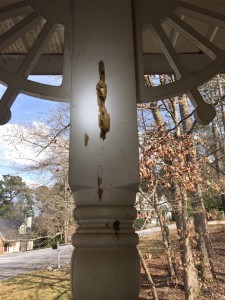Grey Squirrels
March 8, 2016When Carpenter Bees and Woodpeckers Attack
March 21, 2016Carpenter bees are starting to emerge from the winter we have had in Georgia. Our greater Atlanta customers are beginning to call for the carpenter bee treatments to their home to help prevent wood damage that these insects cause. Carpenter bees look similar to bumble bees at a casual glance but when you look closer you will notice a bumble bee has hair on its abdomen, these hairs are typically yellowish in colour. Carpenter bees have a black shiny abdomen with no hair. Bumble bees are excellent pollinators because of these hairs.
Another difference between bumble bees and carpenter bees is their nesting habits. Bumble bees create nests like honeybees and wasps. Carpenter bees bore holes into wood and lay their eggs in the tunnel. This can be quite destructive to your home. This damage can cause wood rot to set in prematurely on your home. Not to mention that if woodpeckers find these critters living in your home they will go to any lengths to get at these tasty morsels by beating your home to pieces. To gain access to the egg chamber they must peck the tunnel apart. The tunnel may stretch up to 7 to 10 feet in length.
Once woodpeckers find these carpenter bees a lot of people call us about removing the woodpeckers from their homes. Unfortunately current federal law prohibits removal of the bird without a special permit from the US Fish and Game office. These aren’t just handed out either. Requests for these permits are frequently denied because of the protection status afforded to these birds under the Federal Migratory Bird Act. The government does allow hazing of the birds and this tactic can prove quite successful if done correctly. Urban Wildlife Control technicians have years of experience in doing this so calling us to help convince these bird to move on is a good bet for you!
Also, if you call about bird damage we can identify carpenter bee issues as well as other insect issues that may be present on your home and come up with a pest control solution for your home. Look at the picture above, notice on the bottom the 3/8″ hole that is where the carpenter bee began boring into the column. Above is damage caused by woodpeckers once they found the bees.


